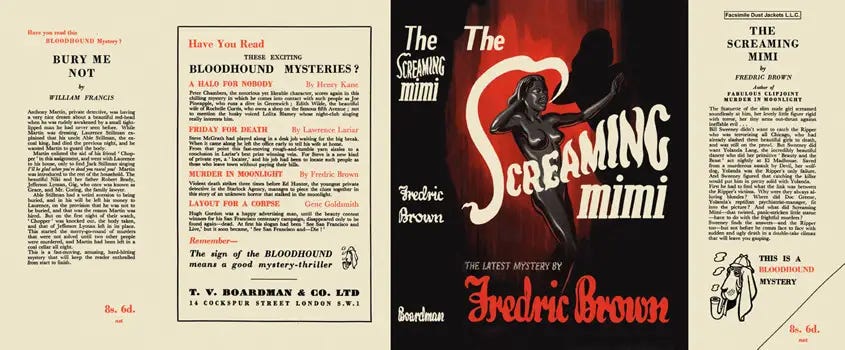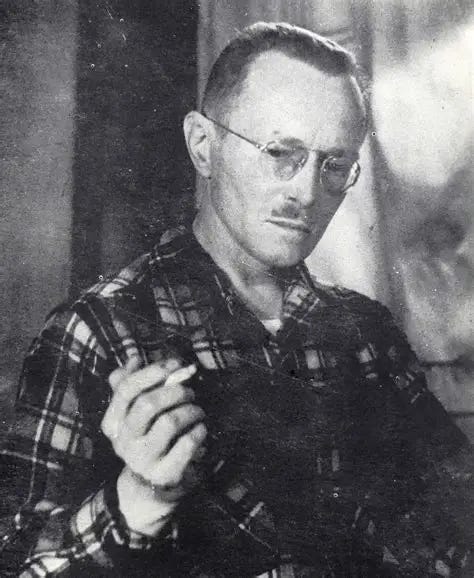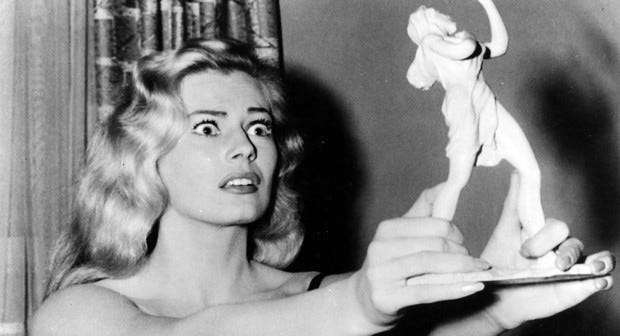Friends, we have reached the period of High Summer. ‘Tis the time for lazy Sundays in the sunshine and late afternoons reading in the rain. Such timeless traditions rooted in seasonal bliss bring me joy. And speaking of traditions, this semi-popular blog will herein return to its bread and butter with yet another book review pulled from Karl Edward Wagner’s legendary 39 List. This time around the book in question is Frederic Brown’s The Screaming Mimi (1949). Listed as one of the Thirteen Best Non-Supernatural Horror Novels of all time, this slim and punchy serial killer story concerns the Chicago Ripper and the alcoholic reporter hot on his on his trail.
Frederic Brown (1906-1972) was apparently a strange duck. Brown, a prolific writer of sci-fi, horror, and mystery tales, hated to write and did everything possible to avoid his typewriter. Born in Cincinnati, Brown only spent a year in college before eventually moving to Milwaukee. There, Brown found his trade as a proofreader for a local newspaper, and later in life, the thin, angular-looking man became something of a celebrated editor. Fans of the original Star Trek may recognize Brown’s name, for it was his 1949 short story “Arena” that inspired arguably the most infamous episode in the show’s history. Others might remember Brown for his pithy “Knock,” which begins with two immortal sentences which have become known colloquially as “the world’s shortest horror story:”
The last man on Earth sat alone in a room. There was a knock on the door……
Besides flash fiction (which Brown specialized in), he also wrote full-length novels. His first, 1947’s The Fabulous Clipjoint, earned Brown an Edgar Award for Best First Novel. The down-at-the-heels version of Chicago that appears in The Fabulous Clipjoint also appears in The Screaming Mimi, where all the action begins with a man named God.
“God” is none other than a homeless alcoholic from Boston named Godfrey. His drinking partner on a hot summer day in August is Sweeney, a journalist for the Blade. Both men find themselves drunk and without purpose in the Near North Side. Sweeney, who has been on a week-long bender, contemplates robbing a “fairy” but gives up the idea. Instead, he receives a pep talk from God about how anything can be accomplished if it includes belief. Even getting a woman—all you have to do, Sweeney, is want her bad enough.
Sweeney does find a girl that night, but she’s the victim of a violent assault. Sweeney stumbles upon the wounded and nude body of a burlesque dancer named Yolanda Lang, who somehow manages to survive a straight razor cut across the guts. After Yolanda and her pooch are taken from the scene, Sweeney hurries to a phone and dictates the story to a copywriter at the Blade. The story becomes a sensation, and by the next morning, everyone in Chicago knows that Sweeney helped save a woman from being another victim of the Chicago Ripper.
Sweeney proves unsatisfied with his one night of heroics. Flushed with cash thanks to two weeks of vacation pay (a vacation that Sweeney forgot all about during his bender), Sweeney becomes the unofficial lead investigator on the Chicago Ripper case. He digs through the files on the previous victims and learns that they were all beautiful and blonde like Yolanda. Sweeney also learns that the Ripper’s last victim (another showgirl type) was the owner of an ultra-rare statue. Nicknamed “The Screaming Mimi,” the ebony statute depicts a nude woman shrieking in terror at the sight of an unknown assailant. Intrigued, Sweeney learns from a flamboyantly gay art dealer (who is routinely called a ‘faggot’ in the novel) that only two such statues exist in Chicagoland. Eureka! Sweeney knows that the other “Screaming Mimi” must belong to the Ripper…
For most of the novel, Sweeney suspects that the killer is one “Doc” Greene, a slimy theatrical agent and Yolanda’s head booker. Greene is intelligent and a little too polished for Sweeney, and when the reporter learns that Yolanda’s contract at a mob-run club is shockingly cheap, he suspects Greene even more. It should be noted here that Greene’s appellation of “Doc” comes from the fact that he is a licensed, but non-practicing psychiatrist. A head-shrinker running go-go girls? Yeah, that is fishy!
The case takes a sharp left turn when Sweeney travels to Brampton, Wisconsin. There he meets the sculptor of “The Screaming Mimi.” “Crazy” Charlie Wilson admits to Sweeney that he based the statuette on his late sister, who died in the madhouse after almost being murdered three years before. The murderer in that case was the Wisconsin Ripper—an escaped lunatic whom Charlie took out with a shotgun blast. Could the Wisconsin killer be on the loose in Chicago? No way, Sweeney knows. However, the cases are connected. They HAVE to be connected. Sweeney decides to play his ace card, and after returning to his job, he writes a column telling the whole city that Ripper is the only living soul who owns a copy of “The Screaming Mimi.”
SPOILER ALERT — DON’T READ ON UNLESS YOU WANT EVERYTHING RUINED
Sweeney’s story causes an immediate ruckus. The Ripper is caught when the police gun down Doc Greene inside of Yolanda’s apartment. Given that Greene was caught trying to kill Yolanda, it would appear obvious that he is the Ripper.
But he’s not.
After the police close the case, Sweeney visits the stripper one last time and lays it all out for her. Yolanda Lang is in actuality Charlie Wilson’s insane sister. She did not die in a mental asylum. Instead, her psychiatrist (Greene) took her away and tried to return her mind to sanity out in the real world. All of Greene’s hard work burned away when Yolanda saw her brother’s statuette. Driven to kill by a perverse mixture of embarrassment and displaced identification with her long-dead attacker, Yolanda was almost stopped by Greene’s shock treatment, i.e. the attack on her that Sweeney discovered at the novel’s beginning was nothing more than a non-lethal attempt by Greene to disrupt Yolanda’s murderous thought patterns. Greene’s final “attack” was something similar. In the end, after Sweeney manages to talk Yolanda into a kind of psychotic stupor, she is arrested by the cops. Sweeney celebrates his victory by returning to the Near North Side, returning to the bottle, and returning to the wisdom of God.
Brown’s novel has been adapted for the movies twice. The first came in 1958, and it stars buxom beauties like Anita Ekberg and Gypsy Rose Lee. Set in California and New Orleans instead of Chicago, director Gerd Oswald’s noir is forgettable and a thin rehash of the novel. The film’s one good quality is that it’s short (under eighty minutes). The other, more famous adaptation came in 1970 when Italian director Dario Argento adapted The Screaming Mimi as the gory giallo, The Bird with the Crystal Plumage. Argento’s film is a stylish masterpiece that differs quite a bit from Brown’s novel. Of the two films, The Bird with the Crystal Plumage is the more entertaining and memorable offering.
The Screaming Mimi is a well-written mystery that does include a surprise conclusion. Brown was a helluva writer, and this novel shows that his skills were already honed before his peak in the 1950s. Still, I cannot sign-off on The Screaming Mimi being one of the Best Thirteen Non-Supernatural Horror Novels. For starters, there’s not much horror in it. The majority of the Ripper crimes are not covered in the novel, and there is little bloodletting beyond Yoland’s first assault and Greene’s death. Whereas some mystery novels absolutely overlap with the horror genre, The Screaming Mimi is not one of them. It is instead a mildly hardboiled mystery tale featuring a likable rake as the protagonist. It includes plenty of witty banter and non-PC language. It has a lot to show for itself, and is worth reading, but KEW missed the mark here.
3.0 out of 5 stars.





